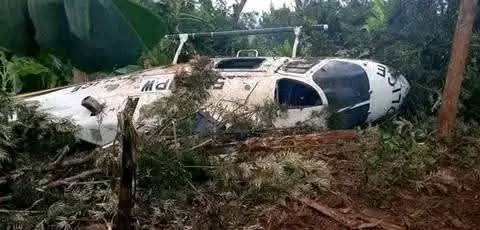BY AUSTINE OGOLLA: A viral video showing a police helicopter wobbling before crash-landing while evacuating mudslide victims in Elgeyo Marakwet County has once again drawn national attention to the critical state of Kenya’s aviation safety.
The helicopter, which was evacuating victims of the devastating Marakwet landslides, lost balance during take-off before landing roughly on its wheels.
Fortunately, no injuries were reported. Yet, the incident is a sobering reminder that recommendations made in previous air crash investigations must be fully implemented to prevent future tragedies.
Lessons Written in Loss
Kenya’s skies have witnessed painful episodes that offer valuable lessons for aviation safety improvement:

- April 2024: The country lost General Francis Ogolla, the Chief of Defence Forces, and several senior officers when a military helicopter went down in West Pokot County. This tragedy underscored the importance of sustained investment in aircraft safety, maintenance, and training.
- June 10, 2012: Internal Security Minister Prof. George Saitoti and Assistant Minister Joshua Orwa Ojode died in a police helicopter crash in the Ngong Hills. The official inquiry provided detailed recommendations on maintenance practices and pilot preparedness, many of which remain relevant today.
- June 2008: Roads Minister Kipkalya Kones and Assistant Minister Lorna Laboso perished in a light aircraft crash in Narok, prompting calls for better coordination between flight operations and meteorological services.
- April 2006 (Marsabit): The crash that killed Dr. Bonaya Godana and 13 others recommended improved maintenance schedules and stricter compliance with safety standards in changing weather conditions.
These and other investigations, including the 2003 Busia crash that claimed Labour Minister Ahmed Mohammed Khalif, all produced clear recommendations meant to prevent recurrence. However, consistent implementation has been the perennial challenge.
Each tragedy has left behind valuable insights that, if fully acted upon, could strengthen the safety framework guiding government-operated aircraft.
It is time for a coordinated approach between the Kenya Civil Aviation Authority (KCAA), the Ministry of Transport, the Kenya Defence Forces (KDF), and the National Police Service Airwing to ensure that recommendations from past investigations are comprehensively enforced.
Regular safety audits; enhanced maintenance documentation; Continuous capacity building for pilots and engineers.
These are essential steps toward safer skies. Implementation must not be driven only by tragedy but by policy and proactive planning.
Government aircraft serve vital roles in humanitarian response, medical evacuation, and national security.
Ensuring their safety is a duty that extends beyond departments; it reflects the nation’s commitment to the lives of those who serve and the citizens they protect.
The Marakwet near-miss offers a timely, urgent reminder. Rather than simply assign blame, it must renew the national resolve to act on recommendations already made.
Kenya has the technical and institutional capacity to ensure that every air crash report leads to tangible, lasting improvements.
As the country continues to modernize its air operations, the focus must remain on prevention. Implementing the lessons of the past is the surest way to secure the future of Kenya’s skies.

